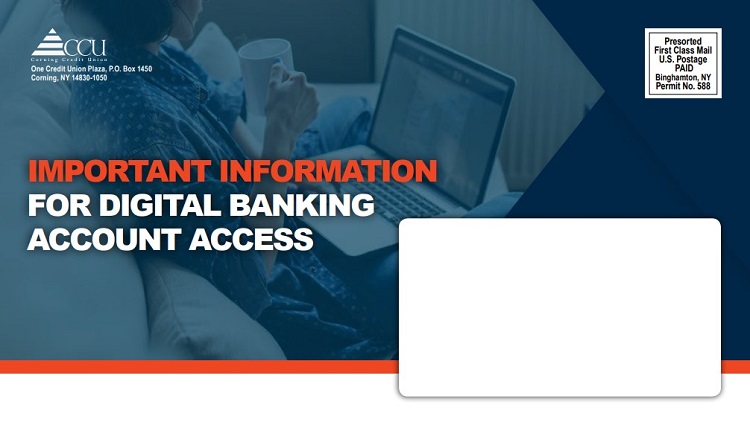Top-Level Takeaways
-
Corning Credit Union converted its online and mobile banking provider in January 2019.
-
Leading up to the conversion, the credit union ensured members knew how to navigate the new platform so none were surprised when it changed.
CU QUICK FACTS
Corning Credit Union
Data as of 03.31.19
HQ: Corning, NY
ASSETS: $1.5B
MEMBERS: 110,365
BRANCHES:21
12-MO SHARE GROWTH: 4.1%
12-MO LOAN GROWTH: 5.7%
ROA: 0.94%
For the past several years, Corning Credit Union ($1.5B, Corning, NY) has been thinking about its future. In particular, the credit union has been working on a digital strategic plan to better serve members in the channels they most use.
After an assessment more than two years ago, Corning recognized its then-mobile and online banking provider wasn’t suited for the credit union’s long-term plans. At the end of 2017, the credit union set out on a 12-month RFP process in search of a provider that would help the cooperative upgrade the look and functionality of its technological experience and continuously evolve its features and functionalities in the years to come.
After signing with Alkami, Corning kicked off a yearlong implementation process that culminated in a January 2019 go-live date. The scale and potential for disruption the conversion presented meant communication would be integral to a successful rollout, so the credit union created a formal team to run a three-pronged outreach strategy.
Our biggest fear was that we would get to go-live and members would be shocked we were making a change, says Stephanie Carl, director of marketing and digital experience at Corning. We wanted no surprises.
The No-Surprise Mindset

Stephanie Carl, Director Of Marketing And Digital Experience, Corning Credit Union
Corning created a project team specifically focused on the technical aspect of the conversion. But the team, which included Carl, CIO Mark Hufnagel, and two additional senior leaders, learned quickly that there was more to the conversion than changes to technology.
We saw that communication was going to be as important as the technical aspects of the conversion, Carl says.
That spring, Corning created a second project team solely focused on communication. The teams initially met every few weeks to discuss various subprojects, but as the months rolled on, the teams began to meet weekly and sometimes more often to ensure rollout efforts remained on the rails.
The communication team tailored messaging for three key stakeholders: members, employees, and Corning’s training and education department. The credit union has some 50,000 users of its mobile and online systems, and the team had to prepare these members for the coming change to minimize disruption.
We acknowledged that this was going to be the most disruptive thing we’d done since our core conversion, Carl says. There was no way to fully eliminate friction, but we worked to make things easy to understand.
A Communication Plan
Using the January go-live data as its guiding light, Corning devised a 90-day communication plan leading into the new year. The credit union, however, started prepping members even earlier than that.
Save The Date?
Corning Credit Union never told members the exact go-live date for the digital banking conversion. Instead, it gave them a timeframe that the credit union narrowed as the actual date grew near.
We knew we were going to be busy the first day, says Stephanie Carl, Corning’s director of marketing and digital experience. We didn’t want our entire userbase trying to register for the new system at once.
Corning added language to its monthly e-newsletters and its annual printed newsletter informing members that a change was coming to digital banking. During these early communications, the credit union did not specify the go-live date or offer much detail.
We introduced the idea that there was a change coming, Carl says. If we hit members right away with all the features and functionality, they would get excited and there would be too long of a lag between when they heard and when they could get their hands on it.
As the months marched on, Corning provided more detail about what was coming. Of particular note, the credit union would transition from an account-centric experience, which requires separate log in credentials to access different accounts, to a member-centric one that would allow members to see all their accounts associated with Corning.
In addition, Corning launched a microsite with tutorials, videos, FAQs, and information about the functionality of the new digital banking platform. The credit union created all of the content, with the exception of video production, in-house and promoted it in member emails, too.

In preparation of its mobile and online banking conversion, Corning launched a member-facing microsite that served to answer just about any conversion question members would throw their way. Click here to view the full site.
When Corning hit the 90-day mark, it sent two mailers to its entire userbase. The jumbo, two-sided postcards contained more information about what was to come, including the go-live timeframe.
Within 30 days of go-live, Corning asked its branch and call center teams to start talking about the conversion during member interactions, asking members if they knew it was coming and did they have any questions. A week-and-a-half before go-live, Corning mailed a three-paneled leaflet that offered a granular guide to the conversion.

Corning sent members a three-paged mailer that included, among other things, details on how to register for the new digital banking platform. Click here to download the full guide.
We know members are busy, Carl says. We tried to overcommunicate and hit them in as many channels as possible.
Registration And Go-Live
Because Corning was transitioning from an account-centric model to a member-centric one, it could not simply upload conversion files to a new provider. Instead, every digital banking user had to re-register, which complicated the conversion process. That process would grow even more complicated if the credit union had inaccurate or outdated contact information.
Having up-to-date contact information in our core was crucial to ensuring that members could register without issue, Carl says.
3 Tips To Go-Live With No Surprise
Stephanie Carl, director of marketing and digital experience at Corning Credit Union, shares three ways her credit union ensured a smooth digital conversion in January 2019.
- Don’t publish the go-live date: Knowing what call volumes were like on Day 1, and knowing they were even higher on Day 2, I can only imagine what would have happened had we published a specific date.
- Think carefully about the date: Our go-live was a Tuesday, mid-morning. Check your typical daily digital banking volume and make an educated decision about where to best set your conversion date.
- Go all the way at once: At first we considered requiring members to register, then allowing them to choose a username and link accounts later. We didn’t, and we’re glad. For us, it was right to do it all at once and then have members settle in.
So, in addition to its general communications about the conversion, the credit union also had to solicit updated contact information, namely email addresses, which were especially important for joint account holders.
It had been years since Corning had made a concerted effort to verify contact information. In this instance, it attacked the task on three fronts. First, it installed a form behind its then-digital banking system for members to self-verify. Second, it asked front-line and call center personnel to verify members in person. Third, it made the call-to-action in its conversion communications a request to verify. Additionally, it actively tracked the email accounts from which marketing emails had bounced and targeted those members in its verification efforts.
It worked, and it was one of the reasons we were so successful, Carl says. So many members were able to register themselves without needing to call for help.
Corning staffed up its call center for the go-live date, but, overall, the conversion was smooth. The credit union estimates 80%-90% of members had no issues registering or logging into their accounts. Carl sees this as evidence the credit union communicated successfully about the conversion. In fact, members were so well informed that Corning heard several comments in the few weeks directly before go-live that members wanted the credit union to just do it already!
Once we started hearing those messages, we realized we’d achieved our goal, at least for some members, Carl says. We’d overcommunicated to the point that none of them were surprised.
